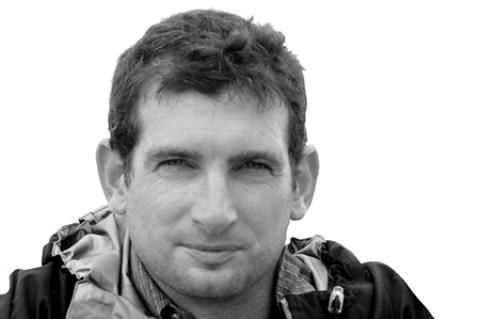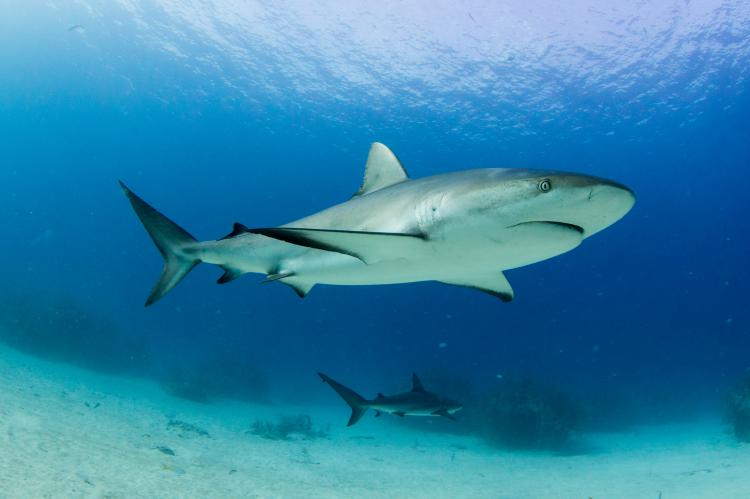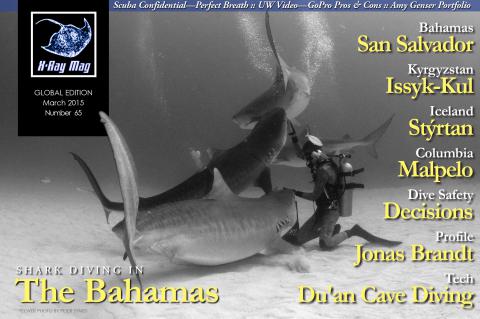Bahamas shark feeder course
Many people are scared witless by sharks, but I love them. I scuba dive and freedive with them whenever I can.
Ever since I started diving, I’ve been an elasmobranch fan. On my open water qualifying dives, I saw sand tiger sharks on every dive. On the deep dive for my advanced open water, I apparently shared it with 12 mantas and swam with a whale shark on the way back. I say "apparently" as I was incapable of counting them; I just stared in awe at the creatures as they cruised around me for 20 minutes.
Then, I moved to South Africa, became a divemaster on Aliwal Shoal, enjoyed hundreds of sand tiger shark encounters and did half a dozen baited tiger shark dives. Recently, I was offered an opportunity to take my passion to the next level—a shark feeder program in the Bahamas.
The dive centre in the Bahamas, which offered the course in shark feeding, was run by the legendary shark wrangler, Stuart Cove. The centre looked more like a small village, as the 50-odd employees in bright pink t-shirts kept the flow of customers moving through the registration, gear-fitting, kit-up and departure processes. This was a well-oiled machine run by an experienced team and it was indeed an impressive sight to see.
As soon as I had signed the usual pre-dive paperwork and some rather lengthier tomes (due to the additional risks involved in giving bait to sharks), I was introduced to two of Stuart’s most experienced shark feeders and instructors, Chang and Ryan.
Before the underwater fun could begin, there was a morning of classroom preparation. After taking me through a Shark Awareness Specialty Course—which covered species identification, polite and aggressive behaviours—we talked about the Caribbean reef shark's (Carcharhinus perezi) predatory habits and movements. We also looked at shark body language—basically how to spot an aggressive or agitated shark and what to do about it.
Diving
In the afternoon, I was to observe and shoot Stuart Cove’s two-dive “Shark Adventure” on a wreck called the Edwin WIlliams. On the first dive, we swam over the wreck to get our bearings and then circled around the site, with some large sharks joining us and then swimming off.
After a 30-minute surface interval, Chang, the shark feeder, kitted up with a suit of chainmail and a Neptunic helmet, and began his in-depth briefing. Carrying more weights than normal, we would be placed around the rails on the stern by his assistant who would also be the cameraman for the dive. We could either stand or kneel at our stations and observe the feed, keeping our cameras (and arms!) close to our bodies. I was given free rein to move around the deck and had a set of chainmail arms on.
Once we were in position, Chang came down to join us, looking like a cross between a downhill skier and a scuba diving medieval knight. Weighted down by a steel box containing carcasses of dead grouper and lionfish, he dropped into the middle of the deck, somewhat like an underwater rocketman landing. I looked around and counted close to a dozen sharks in or around the aft deck. Most of them were nearly three metres in length.
Chang started his show, slipping a piece of carcass onto a metal rod and slowly waved it up and down. Soon, one of the larger sharks cruised in, with mouth wide open, and took the snack.
And it really is just a "snack". A 2010 study into the effects of “shark provisioning” in Nassau on Caribbean reef sharks by Aleksandra Maljković of Simon Fraser University, Burnaby, British Columbia, Canada, showed that the fish given to the sharks during such tourism-related shark feeding activities essentially went to the largest sharks. Even then, it was calculated that the nutritional value of the fish consumed by the sharks was nowhere near enough to constitute their sole food source.
As Chang moved round the deck, each diver got a close-up experience with the three-metre sharks, and an opportunity to get a shot of them taking the bait right in front of them. The sharks would occasionally bump my strobes out of position in their eagerness to get to the fish, so I had to move my hands and arms around.
At one point, this happened as a piece of fish came off the feeding stick. I hadn’t seen it floating towards me, but a couple of the sharks had and zoomed in. I was looking through the viewfinder at that point—my left arm outstretched to realign a strobe—when I felt the slightest pressure on it. I looked to my left and saw a 2.5-metre reef shark with my bicep in its mouth! In a second, it realised its mistake and let go. I was glad I had the chainmail suit on!
After everyone had a good eyeful, Chang closed the bait box, extended a hand to a passing shark, and began rubbing its snout. Having its ampullae of Lorenzini (electroreceptors on the snout) stimulated by the chainmail glove, the shark stopped moving completely. In a state called “tonic immobility”, the shark looked like it was in a blissful stupor, as if it was having an itchy spot on its back scratched.
Chang put his other hand on its dorsal fin and rotated the shark 360 degrees around, to show it to the group. When he stopped rubbing, the shark came out of its trance after a short while, and then swam off. Incredible.
As we all ascended to the boat and got out of the water, Chang fed the last pieces of fish to the sharks, keeping them busy. Back on the deck, looking around, there was not one person who did not have a huge, shark-like grin on their face.
Shark Arena
On the second morning, we had a debriefing in the classroom and looked at the mechanics of shark feeding: how to get the bait on, how to attract the sharks, and how to give the guests the best experience.
That afternoon, I went out on the shark adventure with Ryan. I listened to his briefing very carefully and observed him even more closely. On the first dive, we headed out to Shark Arena, an area of open sand with large stones placed in a circle. We swam over the site, past a wreck and over the reef wall.
Within a few minutes, inquisitive Caribbean reef sharks appeared, following us along the wall. Circling back and approaching the arena from the other direction, close to a dozen were already milling around the general vicinity.
Forty-five minutes later, back in a shark suit, I was in the middle of the arena with my camera, with the best seat in the house. There were nearly three times as many sharks compared to my experience at the Edwin Williams. Here, many were smaller, two-metre specimens. They seemed a little friskier than those the day before, but I was absorbed and loved being in the midst of so many beautiful big fish. They would swim out of the arena before circling back round, coming in from all angles. It was pretty intense and I found myself giggling into my regulator.
Day three
Twenty-four hours later, I was giving the briefing under Ryan’s supervision. Today, I was going to feed with him.
“Do they ever go a bit crazy?” had been one of my questions. “You just gotta treat them like playful dogs sometimes,” he replied.
Except, these were 75 to 100kg, three-metre-long puppies. With a lot more teeth. And we were in their element—underwater.
We dropped in together, the weight of the chainmail and bait box requiring a decent amount of air from my BCD. There were 30-plus sharks again, looking pretty playful, I thought. Ryan got the ball rolling and then handed the feeding stick to me.
I looked around and found a big shark coming from the edge of the circle. I speared a snack and waved it slowly towards the photographer. Wave it too fast, the bait comes off and a minor free-for-all starts; go too slow and the sharks don’t see it. Nevertheless, in she came. Her nictating membrane (translucent third eyelid) closed (as it often does when a shark is about to use its mouth), and then her jaws similarly closed around the stick, and I slid it away. Ryan gave me the big OK sign and a pat on the back.
As we continued the feed, a couple of bits fell off and the sharks started to get a bit feisty. Ryan was barely a metre away but at times I could hardly see him—the sea was thick with sharks. I got a tail swipe to the head and realised that the helmets were not just for show. Then another tail swipe or passing pectoral fin pulled the regulator out of my mouth. It seemed like "playful dog time" was upon us.
I asked whether I should pause the feed. Ryan agreed and I clipped the heavy box shut. Following Ryan’s lead, I placed my hands on the flank of a passing shark and shoved it sideways. We were back-to-back, clearing space around the bait box. Somehow, it reminded me of the time I trained my German Shepherd... sort of. Rather than agitate them, the action seemed to calm them down. After 60 seconds or so, things were back to normal.
Patting a shark
So I could feed them. But could I put them into tonic immobility? Again, Ryan led the way, and I copied him, placing my hand palm down on a passing shark’s head, sliding it to the snout and wiggled my fingers inches from its mouth. “The bigger they are, the faster you have to wiggle,” Ryan said in the classroom.
I had picked a medium-sized shark, just about two metres long. I was wiggling and tickling it as fast as I could, and then the shark stopped moving! I maneuvered it onto the sand and knelt down, rubbing its nose and stroking its back. If I hadn’t had to keep my regulator in my mouth, my jaw would’ve dropped open and hit the sand.
It was quite an emotional experience. Not at all the “man tames shark” testosterone buzz you might expect. There is a definite love-at-first-sight feeling, except it happens every time with every shark, coupled with a weird combination of inner peace and astonishment. I didn’t want to stop, but there were customers to entertain.
I had some fun at the end, getting them as close to the cameraman as possible but, all too soon, I was down to the last morsel. I picked out a little shark with a fish hook stuck in its mouth, gave him his sharky snack, and said a silent thank-you and good-bye to them.
It was truly a wonderful experience, and looking back on it, it's still very difficult to accurately describe my emotions—the best I can do is say, "Fintastic!"
Shark feeding and baited dives—for or against?
Shark feeding, or "provisioning" as the scientists call it, and baited shark dives are the subject of considerable debate amongst divers. The main point of contention being that it is not natural and alters sharks' behaviour. In the specific case of the feeding that takes place off Nassau, a peer-reviewed paper published in the journal Biological Conservation states that there is no negative effect in this case. The full paper, Effects of tourism-related provisioning on the trophic signatures and movement patterns of an apex predator, the Caribbean reef shark, by Aleksandra Maljković and Isabelle M. Côté can be found at: www.sciencedirect.com
In other areas where I have been on fed or baited dives—at Aliwal Shoal in South Africa, Andros Island and Tiger Beach in the Bahamas, and in the Turks and Caicos—I believe natural behaviours have been changed. However, I personally consider that these changes are not harmful to the sharks, and the benefits of allowing divers to observe them at close quarters outweigh any potential negatives. A study into the blacktip sharks residing off the southern end of Aliwal Shoal has started and will enable greater understanding of their behaviour. ■
The author thanks Indigo Safaris (www.indigosafaris.com), the dive travel specialists through whom he arranged his trip to the Bahamas. Christopher Bartlett is a widely published British underwater photographer and dive writer based in France. He leads photographic safaris to locations like the Bahamas, Turks and Caicos Islands, as well as locations in Africa, teaching underwater workshops in Zanzibar and Papua New Guinea. For more information, visit: www.bartlettimages.com.
Download the full article ⬇︎

Originally published
X-Ray Mag #65
Diving with tiger sharks in the Bahamas; San Salvador Island; Ancient remains in Kyrgyzstan's Lake Issyk-Kul; Iceland's hydrothermal vents at Stýrtan; Malpelo Island; Wreck diving on the HMS Warrior II; Dive safety decisions; PFO & diving; Poseidon's CEO Jonas Brandt profile; Cave diving in China's Du'an county; Scuba Confidential on the perfect breath; A case for unsweetened tea; GoPro's pros & cons; Amy Genser portfolio; Plus news and discoveries, equipment and training news, books and media, underwater photo and video equipment, shark tales, whale tales and much more..
.



